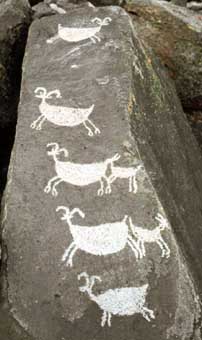Coso Rock Art District facts for kids
|
Coso Rock Art District
|
|

Bighorn sheep, a characteristic design at Coso
|
|
| Lua error in Module:Location_map at line 420: attempt to index field 'wikibase' (a nil value). | |
| Location | Mojave Desert, Coso Range, Big and Little Petroglyph Canyons |
|---|---|
| Nearest city | China Lake, California |
| NRHP reference No. | 99001178 |
Quick facts for kids Significant dates |
|
| Added to NRHP | October 8, 1999 |
| Designated NHLD | July 8, 2001 |
The Coso Rock Art District is a special place in California. It holds over 100,000 ancient pictures carved into rocks. These carvings are called petroglyphs. They were made by early people, possibly Paleo-Indians or Native Americans.
This district is found near the towns of China Lake and Ridgecrest, California. Two important areas within it, Big and Little Petroglyph Canyons, became a National Historic Landmark in 1964. Later, in 2001, they joined a larger National Historic Landmark District.
The Coso Rock Art District has many canyons. Besides Big and Little Petroglyph Canyons, there's Renegade Canyon, Haiwee Springs, Dead End Canyon, and Sheep Canyon. Each canyon has thousands of petroglyphs.
The rock art in the Coso Range mostly shows six main things:
- bighorn sheep
- entoptic images (patterns seen when eyes are closed or from dreams)
- human-like figures (called anthropomorphic), sometimes mixed with animal parts
- other animals
- weapons and tools
- "medicine bag" images
Most of the Coso Range is on the Naval Air Weapons Station China Lake. This means visits are controlled, which helps protect the ancient art. The Coso Range is located between the Sierra Nevada mountains and the Argus Range. The Indian Wells Valley is to its south. This area covers about 400 square miles (1,000 km²). It has many volcanic rock formations. The most common animals shown in the art are bighorn sheep, deer, and antelope.
The Coso Rock Art District is a famous spot. A Los Angeles Times article in 2007 listed it as one of the top 15 places to visit in California. It was also mentioned by Groupon as part of the Ridgecrest Petroglyph Festival.
Ancient Art and Its Secrets
No one knows for sure who created the amazing images in Little Petroglyph Canyon. Some of these carvings might be over 10,000 years old! We also don't know why the dark basalt rocks in the dry Coso Mountains became a giant canvas. These rocks are at the northern edge of the Mojave Desert.
The art shows many bighorn sheep and hunters with bows and arrows. This area is likely the richest Amerindian rock art site in the Western hemisphere.
To see this incredible canyon, you need to plan ahead. You can contact the Navy Base directly. Or, you can join a tour offered by the Maturango Museum in Ridgecrest, California. They also have a "Rock Art 101" program. The trip involves a 40-mile drive, with the last 6 miles on a dirt road. Then, you hike and climb a bit along the canyon. Tours are only scheduled in the spring and fall.
Who Made the Art?
Archaeologists have found much evidence about the people who lived here. These people are called the Coso People. They might have been part of the Paiute tribe. They traded with other Indigenous peoples of the Americas tribes.
For example, archaeological finds show they traded with the Chumash People. Evidence of this trade has been found at coastal sites in San Luis Obispo County and on the Channel Islands.

